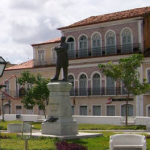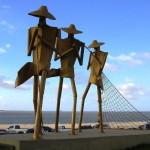[gn_spoiler title=”Teatro Arthur Azevedo” open=”0″ style=”2″]
This theatre, the second oldest theater in Brazil, was opened in 1817 under the name Union Theatre. It was renamed Teatro São Luís in 1852 and adopted its current name in 1922, used as a cinema between 1940 and 1966. In 1989 it was demolished and rebuilt based on the original design.
An Italian horseshoe-shaped theater, Teatro Arthur Azevedo is in neoclassical style and has a capacity of 750, over 4 floors. It is open to the public for guided tours and shows.
Phone: (98) 3218-9900
E-Mail: taa@cultura.ma.gov.br
The seat of the state government, Palacio dos Leoes once housed a fortress erected by the French in 1612. After the capture of the city by the Portuguese and successive reforms, it became the imposing neoclassical building with 3000 square meters of building area. During the tour, you will see rooms filled with carpets and chandeliers from France, furnished and decorated with pieces from the 18th and 19th centuries, as well as prints that belonged to the poet Arthur Azevedo.
- Open to the public: Wed/Fry 14h/17h30, Sat/Sun 15h/17h30
- Adress :Av. D. Pedro II (Centro Histórico),
- (98) 3232-9789 (Telephone)
Built by the Jesuits, Se Church is a tribute to Our Lady of Victory, protector of the Portuguese in the battles against the French army in St. Louis in 1922. The highlight of the interior is up to the altar, all coated with gold and done by elaborate indigenous labor.
- Open to the public: Tue/Fry 8h/19h, Sat 8h/12h and 15h/22h, Sun 8h/12h and 16h/21h
- Adress: Pça. D. Pedro II (Centro Histórico),
- (98) 3222-7380 (Telephone)
[/gn_spoiler] [gn_spoiler title=”Lagoa da Jansen” open=”0″ style=”2″]
The State Park of Lagoa da Jansen was created on June 23, 1988 in São Luís, Maranhão state, with an area of 150 hectares.
The famous Jansen lagoon is surrounded by an ecological park. It is 6 square meters in area with restaurants, sports courts, bike paths, lanes for jogging and plenty of space for those who like fresh air and space. Opened in late 2001, the site was transformed immediately into a large community center, frequented by local residents and visitors. One of the busiest spots is the Lookout Lagoon, where you have a comprehensive view of the entire region.
Located between Praia da Ponta d’Areia and San Francisco Neighborhood, the park is squeezed between the sea and the urban area, but maintains an incredible variety of species of fauna and flora of the native forest.
[/gn_spoiler] [gn_spoiler title=”Rua do Giz” open=”0″ style=”2″]In the midst of Historical Center of St. Louis is the Chalk Street, so named because of the belief that, in the past, this has been covered with slippery white clay.
The street has a staircase of the same name composed of 35 broad steps of stone masonry and lined with colonial mansions. The Chalk Street has bars and restaurants and, for the Bohemians, the Seresta Square, where you can sit at night and admire the houses with their special lighting.
[/gn_spoiler] [gn_spoiler title=”Dom Pedro II Square” open=”0″ style=”2″]Located at Dom Pedro II Street in the historic center of St. Louis, home to the Palace of the Lions, the Port Authority Metropolitan Cathedral and the Episcopal Palace.
[/gn_spoiler] [gn_spoiler title=”Praia do Calhau (Beach)” open=”0″ style=”2″]The calm water beach, dunes and vegetation accompany the entire length of the Coastal Avenue. Very busy on the weekend with bathers and people doing sports such as running and cycling, the charm of this beach is the kiosks and restaurants on stilts.
[/gn_spoiler] [gn_spoiler title=”Historic Center” open=”0″ style=”2″]
Narrow streets, alleys, mansions, colonial buildings, staircases, tiles and houses, it is impossible to resist this scenario of an area of 220 hectares.
The main architectural feature of the historic center is to address the concern of the hot and humid weather by waterproofing the facades with tiles. Buildings are L- or U-shaped with large roofs and shutters.
Today vehicle traffic is prohibited on site, and the pavement is as old as the Portuguese empire.



